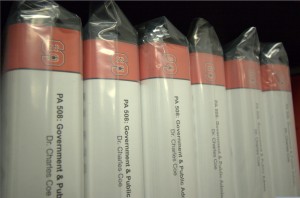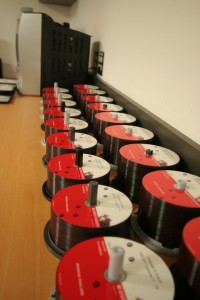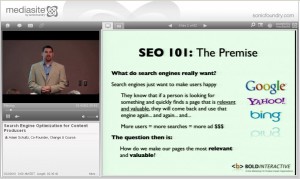No More DVDs: Distributing Podcasted Lectures in the Virtual World
Media Distribution Moves to the Virtual World
When students signed up for a video-based Distance Education (DE) course in 2003, they had to pay a $50 deposit for a box of 25 VHS tapes containing all of their class lectures for the semester. In 2010, when students sign up for a video-based DE course, all they must do is click on a hyperlink where all of their lectures are hosted online.
Distributing lectures for a video-based DE course used to be a large, long, and heavy process. Although DELTA Associate Director of Media Distribution Services (MDS) Peter Watson lightened the load by converting these VHS lectures to DVDs in 2005, these physically-distributed lectures still cost students, the university, and taxpayers thousands of dollars in distribution costs each

In order to streamline efficiency and restduce costs, Watson and his team at MDS; Broadcast and Emerging Media Technicians Bob Pence, Bob Wilkerson, and Brian Dyer; have moved distribution from the physical world to the virtual world, converting over 2,500 unique DVD-recorded lectures spanning over 70 courses to podcasts. Podcasts are streaming and/or downloadable audio or video files made available over the Internet, and cost virtually nothing to distribute.
“Moving to podcasts and other methods of online delivery removed the need for the deposits, the physical transport of DVD’s, the requirement for the student to physically go to the Bookstore and pick up the DVD’s or have them shipped, the production costs of DVD media, production time, physical storage, delivery and retrieval of DVD sets,” Watson said.
Seven Years of Changing Technology
Watson was hired in 2003 to initiate change and bring order and cost effectiveness to the video distribution process. In his first two years at DELTA, Watson phased out VHS distribution completely, converting the entire VHS library to DVD and making digital back-ups.
“Over time, I was able to transition the whole department over to DVDs, but it was still the same model of people getting a box set at the beginning of the semester,” Watson said. “I felt we were a little behind in going over to DVDs in terms of when we were able to get [distribution] all cranked up, but by the time we were distributing DVDs in 2005, you could buy a DVD player for $40.”
According to Watson, there is a delicate balance between lagging behind technological change and being too quick in adopting the newest technology. Although utilizing the newest, most efficient technologies may be ideal for some students, doing so could create problems for other students who are not familiar with or who are unable to access newest technologies.
“[In order to accommodate students who did not own a DVD-playing device] we purchased DVD players and planned to loan them out, but our customer base was way ahead of us, and still is, in many cases. However, if you lag a little bit, you let the market settle, and you don’t get into the next big dud like HDDVD.”
Although DVD distribution was an improvement from VHS distribution, Watson saw that the increasing usability and accessibility of online content offered an even more efficient solution.
“We were dealing with the physical world rather than the virtual world,” Watson said. “[The physical world] takes more time, more energy. Everything in the production workflow slows down: you have to buy the materials, you have to create the materials, you have to package the materials, you have to physically transport the materials.”

This long, expensive distribution process included much more than just “distribution,” according to DELTA Associate Vice Provost of Educational Technology Services Lou Harrison. Because just one scratch on a DVD can destroy some or all of its content, MDS previously had to manually perform Quality Analysis (QA) on every DVD distributed.
“You’re getting these things back and if there s a scratch anywhere on the DVD, it’s not going to work, so you literally have to sit there and watch every DVD,” Harrison said . “[Watson] would hire, through University Targeted Staffing (UTS), four people for two weeks each semester just to sit and watch all the returns and make sure they played. “
The time and money invested in such an inefficient task is just one example of the many inconveniences of DVD distribution.
“DE [produces] material every week, and so taking what the professor said in class for two or three periods and turning it into a DVD and getting it to the student was a real challenge,” Harrison said. “Putting it on the Web takes about an hour and you’re done.”
By 2008, Watson had determined a move to the virtual world was vital to making distribution less costly and more efficient.
So in fall 2008, Watson piloted two courses delivering lectures via podcasts rather than DVDs: Assistant Professor of English John Charles’ ENG 266: American Literature II, and Public and International Affairs Professor and Department Chair Andy Taylor’s PS 301: Presidency and Congress.
Watson received nothing but positive feedback from both professors and students.
According to Taylor, students in his pilot section liked being able to download lectures onto different devices like iPods or laptops, allowing them to view the lectures anywhere. Also, Taylor said that students liked that they no longer had to go to the bookstore to pick up their DVD lectures and pay a deposit.
Charles said that students in his pilot section liked podcasting over DVDs because podcasting eliminates physical transportation and playback which leads to scratched, unreadable DVDs.
Because of podcasting’s many advantages, as well as the overwhelming positive feedback from the pilots, Watson’s team started converting their entire library of DVDs to podcasts in spring 2009. And by the end of fall 2009, Watson’s team had completed the conversion.

To further improve the presentation of streaming podcasts for students, MDS worked with David Tredwell and Mike Cuales in DELTA’s Creative and Multimedia Production Services in fall 2009 to create a Flash Video player for viewing podcasts on computers. Tredwell’s flash video player allows students to easily navigate between lectures, as well as easily navigate specific parts of lectures in which they are interested.
To supplement the implementation of the player, Dyer increased the resolution of podcasts for computer viewing. Previously, podcasts were presented in a smaller resolution (320×240 pixels) suitable for iPods or other portable playing devices. However, using the original video recordings, Dyer increased the podcast resolution to 480×360 pixels, allowing students to more clearly and effectively view their podcasted lectures on a computer screen.
“Before the player we were talking about playing the lectures on your iPhone or iPod, and nobody in their right mind would want to take an entire class on their iPhone,” Harrison said. “So maybe you sit at your computer and watch a … lecture. Then, when you’re on the bus, you listen to the podcast on your iPhone.”

In addition to Tredwell’s flash video player, DELTA is also using Mediasite to host lectures. Mediasite is ideal for courses that use multiple forms of rich media. Mediasite is a rich-media solution that allows instructors to automatically capture and host lectures alongside multiple forms of synchronized media like PowerPoint slides, images, or graphs. Students can even answer polls or ask their instructors questions while viewing live or on-demand lectures. In fact, DELTA and their campus partners recently received three awards at Sonic Foundry’s 2010 Rich Media Impact Awards ceremony on April 15.
Thanks to DELTA’s effective solutions, fall 2009 saw the last DVD-distributed courses, and in spring 2010, Watson discontinued DVD distribution entirely. Students taking DE courses at N.C. State now have the largest library of podcasted lectures of any university in North Carolina, universally and instantly available.
“Every time we’ve moved from one technology to the other, it has saved money, increased access, and made it easier for people to get the content,” Watson said.
What’s Next
“DELTA is a very forward-thinking group, but in particular, Peter and his shop have been consistently looking toward the future of delivery and how to make things better,” Harrison said. “They’ve always been looking out at what the next thing is and what makes sense.”
Watson’s newest project to save money and increase access is to closed-caption the entire library of podcasted lectures.
For universities that have available funds, closed captioning is required by law to support students with hearing impairments. Also, closed captioning serves as a reinforcement for visual learners, students who may be unsure of what certain words spoken by their instructors actually are, students who may be unsure of how to spell certain words, and students in situations where listening to audio is inappropriate or impossible.
However, the traditional method of closed captioning, which requires a person listen and transcribe, is timely, costly, and inefficient.
MDS has accommodated a student in the past with a hearing impairment by manually transcribing the entire course, which proved costly and time consuming.
“At the end of it, we’ve got one class and $6,000 less, with at least 80 more classes to work on. So it’s not realistic,” Watson said.
After extensive research, Watson determined that a speech-to-text software called Docsoft, which runs using the Dragon NaturallySpeaking engine, was the best solution. Speech-to-text software has the ability to listen to live and recorded speech and automatically transcribe what is being said. Although Watson selected industry-leading software, all speech-to-text software has difficulties.
“The knock against speech-to-text [software] is that it’s just not very good right out of the box. There are many examples of mangled, and sometimes unintentionally hilarious, speech-to-text efforts. To increase accuracy, you must train a speaker profile. Let it
record and then read it, correct it, and resubmit it. Then it ‘learns’ how to listen to particular speaker profiles. You can’t imagine it being 100 percent accurate 100 percent of the time, and if it’s truly used by a deaf person, then it must be 100 percent accurate,” Watson said.
After a speaker profile is trained, the software accuracy increases, but to what percentage remains to be seen. Although there are difficulties to the software, Watson’s research has convinced him that the speech-to-text software is worth the time and effort to investigate.
“We know the cost of straight transcription is prohibitive,” Watson said. “If speech-to-text gives us a complete transcript that just needs some editing, we will have made solid headway on a significant goal. We owe it to our students to give it our best shot.”
Now that distribution has moved to the virtual world, MDS isn’t slowing down, increasing access in any situation.
“It is a cost saver for the university and taxpayers; a time saver for everyone, and it provides access to content anywhere, anytime,” Watson said.
Learn more about Media Distribution Services.
- Categories:


